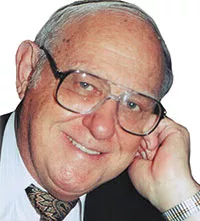This tax victory story is about Joe. Joe, 61, is interesting guy. He’s married to Mary, 60. He’s the owner of a family business, Success Co., professionally valued at $5.6 million. Joe has three kids. His son manages Success Co. and will someday own it. Joe also has seven grandkids.
From my perspective, the most interesting fact about Joe is that he is a member of a 20-person study group (each an owner of a closely held business) that meets monthly. Once a year they invite an estate planning professional (this year a lawyer, Lenny) to talk about "How to Create the Best Estate Plan."
This year, it was Joe's turn to be the case study. After Joe's case study was done (Lenny recommended a few changes), Joe — a long-time reader of this column — called me for a second opinion.
Let's take a minute to talk about the thousands of wonderful estate planning lawyers like Lenny, who like 99% of his peers, is what we call a "traditionalist." Their estate planning goal is to make sure that there is enough liquidity (cash-like assets owned by the client, enough life insurance or both) to pay the potential estate tax.
My goal is much more ambitious:
• Eliminate, or reduce as much as possible, the potential estate tax liability
• Maximize the amount of wealth to the heirs (typically the kids and grandkids).
The plan is set up to make sure Joe and Mary can maintain their lifestyle and keep Joe in control of his assets — including Success Co. — for life.
Now a few more key facts about Joe. He is worth $15 million, which includes Success Co.: nets $1.5 million before tax, after a $300,000 salary to Joe, plus liberal fringe benefits. Success Co. grows on average about 10% per year. Joe earns (after taxes) about $400,000 to $600,000 more per year than he and Mary spend.
The balance of Joe's wealth includes two homes worth $2.7 million (main residence and vacation home), $1.7 million in his 401(k), cash and a stock and bond portfolio of $1.8 million, $2.9 million in income producing real estate and $3 million in sundry assets.
Finally, Joe has $6.2 million of insurance on his life (now owned by an irrevocable life insurance trust, ILIT, per Lenny's recommendation): $1.2 million in whole life and $5 million in 10-year term (six years to the end of the term).
Without getting into every detail, the following are the key changes and additions we made to Joe's estate plan. (Please note we made no changes to the existing documents created by Joe's original lawyer and the changes made by Lenny.)
• Residences (two): Changed titles so Joe's trust owned one-half of each residence and Mary's trust owned the other half. Result: Reduces the value of the homes by 30% for estate tax purposes (a discount of $810,000).
• 401(k) plan: Qualified plan assets, like a 401(k), IRA and similar plans, will be double taxed, income and estate. Instead, we used a strategy called "Retirement Plan Rescue" to use the future income of the 401(k) plan to pay a portion of the premiums on a life insurance policy mentioned later.
• Success Co.: The business grows in value every year. We froze its value by having Joe sell Success Co. to his son Sam via an "intentionally defective trust", or IDT. Under crazy American tax law, every penny Joe receives from Success Co. in payment for the sale to the IDT is tax-free to Joe. Joe keeps control of Success Co. via the voting stock (less than 1%) and sells the non-voting stock (over 99%) created just before the sale to the IDT. The future cash flow of Success Co. will be used to pay Joe for the non-voting stock. A portion of this cash flow will be used to pay the premiums for the life insurance in # 7.
• Stock and bond portfolio: These assets were transferred to a family limited partnership, or FLIP. Once again a discount (35%) as allowed under the tax law reduced the value of these assets for tax purposes by $630,000.
• Income producing real estate: These properties were in three LLCs. The LLC interests were transferred to a separate FLIP. More discounts for estate tax purposes — this time just over $1 million.
• We set up a gifting program to use the $14,000 per year ($28,000 for Joe and Mary) for each of the kids and grandkids. We also used a portion of the $5.25 million ($10.5 million combined lifetime exclusion for Joe and Mary). It should be noted that the plan we created made sure that if any of the kids divorced, the ex-spouse would not share in the family wealth.
• Life insurance: Since no estate tax is due until the second death (of Joe and Mary), second-to-die life insurance (in an ILIT) makes more sense than insurance on only Joe's life. Premiums are $19,160 on Joe per $1 million of coverage and only $11,102 on Joe and Mary for second-to-die. Joe decided to stay with the $6.2 million in coverage, but second-to-die only (dropping the existing policies). Annual premium cost will be $67,722 (to be paid for by #2. and #3. above).
Victory! Our strategies eliminated all of Joe's potential estate tax liability. And that $5 million second-to-die insurance will someday go to the kids. Remember: the term policy will lapse in six years.
Finally, it should be noted that we consulted with Lenny and he approved every one of the strategies listed above.
Irv Blackman, CPA and lawyer, is a retired founding partner of Blackman, Kallick, Bartelstein LLP and chairman emeritus of the New Century Bank (both in Chicago). Want to consult, need a second opinion? Call Blackman at 847/674-5295. e-mail him at [email protected] or visit www.taxsecretsofthewealthy.com




